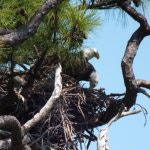Bald Eagles

January 7, 2020 By Katie Roundtree
The Bald Eagle has been the national emblem of the United States since 1782 and a spiritual symbol for native people for far longer than that. These regal birds aren’t really bald, but their white-feathered heads gleam in contrast to their chocolate-brown body and wings. Look for them soaring in solitude, chasing other birds for their food, or even nesting in our area.
The bald eagle is a conservation success story. Today, Florida, has one of the densest concentrations of nesting bald eagles in the lower 48 states. While no longer listed under the U.S. Endangered Species Act or the Florida Endangered and Threatened Species rules, bald eagles remain protected by both the state eagle rule and federal law. Once endangered by hunting and pesticides, bald eagles have flourished under protection.
The Florida Fish and Wildlife Conservation Commission (FWC) documented four nests in northern Palm Beach County in 2017 and a little over thirty nests in all of Palm Beach County. (source: FWC Bald Eagle Nest Locator) One of the nests is located in a preserve area within Abacoa. It was documented by our Staff Biologist and in use up until a few years ago. It is amazing to see one of these large nests up close. Nests can range from about four feet in diameter and three feet deep to over nine feet in diameter and twenty feet deep. Eagles have strong nest site fidelity, meaning they return to the same nest and nesting territory each year. If they successfully produce young at a nest, they are likely to return to that nest year after year. A pair might choose to build a new nest in a different area if their previous nest was unproductive (failed to fledge eaglets) or otherwise proved unsuitable. The FWC has not updated their map since 2017 when the eagles were no longer listed as endangered, so there could be newer nests within our area that have not yet been documented.
Bald eagles are found in areas with large water bodies due to their diet of fish and their hunting techniques. According to the Cornell Lab, rather than do their own fishing, Bald eagles often go after other creatures’ catches. A bald eagle will harass a hunting Osprey until the smaller raptor drops its prey in midair, where the eagle swoops it up. A bald eagle may even snatch a fish directly out of an Osprey’s talons. Fishing mammals (even people sometimes) can also lose prey to Bald eagle piracy. Due to this nature, Benjamin Franklin was not in favor of the bald eagle as our national emblem. In 1784, Franklin disparaged the national bird’s thieving tendencies and its vulnerability to harassment by small birds. “For my own part,” he wrote, “I wish the Bald Eagle had not been chosen the Representative of our Country. He is a Bird of bad moral Character. He does not get his Living honestly. … Besides he is a rank Coward: The little King Bird not bigger than a Sparrow attacks him boldly and drives him out of the District.” If Mr. Franklin had his way, the Wild Turkey would have been our national emblem instead. He believed that the turkey was a true native bird with lots of courage who would not hesitate to attack if provoked. He never publicly suggested the turkey as our national emblem, but wrote about the choice of the bald eagle in a private letter. The story however, makes for a good conversation starter.
